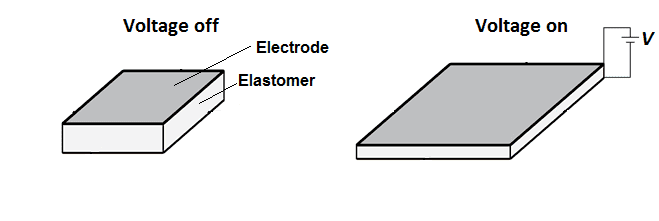 | ||
The basics of dielectric elastomers
Dielectric elastomers (DEs) are smart material systems that produce large strains. They belong to the group of electroactive polymers (EAP). DE actuators (DEA) transform electric energy into mechanical work. They are lightweight and have a high elastic energy density. They have been investigated since the late 1990s. Many prototype applications exist. Every year, conferences are held in the US and Europe.
Contents
- The basics of dielectric elastomers
- Autonomous soft robots without electronics how dielectric elastomers will change robotic development
- Working principles
- Ionic
- Materials
- Configurations
- Applications
- References
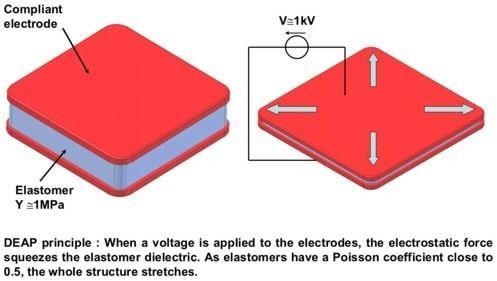
Autonomous soft robots without electronics how dielectric elastomers will change robotic development
Working principles
A DEA is a compliant capacitor (see image), where a passive elastomer film is sandwiched between two compliant electrodes. When a voltage

where
Ionic
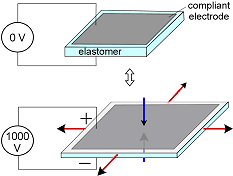
Replacing the electrodes with soft hydrogels allows ionic transport to replace electron transport. Aqueous ionic hydrogels can deliver potentials of multiple kilovolts, despite the onset of electrolysis at below 1.5 V.
The difference between the capacitance of the double layer and the dielectric leads to a potential across the dielectric that can be millions of times greater than that across the double layer. Potentials in the kilovolt range can be realized without electrochemically degrading the hydrogel.
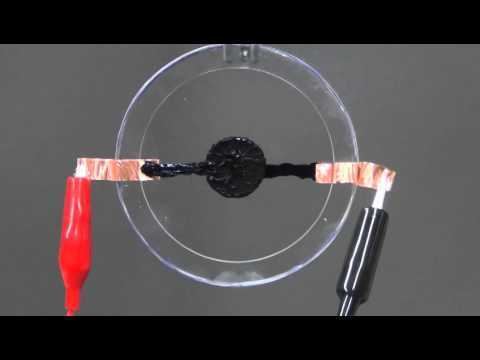
Deformations are well controlled, reversible, and capable of high-frequency operation. The resulting devices can be perfectly transparent. High-frequency actuation is possible. Switching speeds are limited only by mechanical inertia. The hydrogel's stiffness can be thousands of times smaller than the dielectric's, allowing actuation without mechanical constraint across a range of nearly 100% at millisecond speeds. They can be biocompatible.
Remaining issues include drying of the hydrogels, ionic build-up, hysteresis, and electrical shorting.
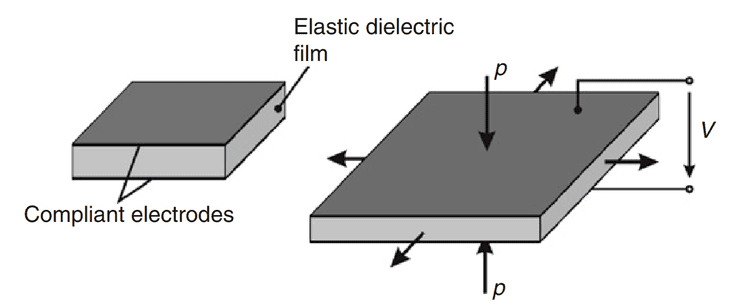
Early experiments in semiconductor device research relied on ionic conductors to investigate field modulation of contact potentials in silicon and to enable the first solid-state amplifiers. Work since 2000 has established the utility of electrolyte gate electrodes. Ionic gels can also serve as elements of high-performance, stretchable graphene transistors.
Materials
Films of carbon powder or grease loaded with carbon black were early choices as electrodes for the DEAs. Such materials have poor reliability and are not available with established manufacturing techniques. Improved characteristics can be achieved with liquid metal, sheets of graphene, coatings of carbon nanotubes, surface-implanted layers of metallic nanoclusters and corrugated or patterned metal films.
These options offer limited mechanical properties, sheet resistances, switching times and easy integration. Silicones and acrylic elastomers are other alternatives.
The requirements for an elastomer material are:
Mechanically prestretching the elastomer film offers the possibility of enhancing the electrical breakdown strength. Further reasons for prestretching include:
The elastomers show a visco-hyperelastic behavior. Models that describe large strains and viscoelasticity are required for the calculation of such actuators.
Materials used in research include graphite powder, silicone oil / graphite mixtures, gold electrodes. The electrode should be conductive and compliant. Compliance is important so that the elastomer is not constrained mechanically when elongated.
Films of polyacrylamide hydrogels formed with salt water can be laminated onto the dielectric surfaces, replacing electrodes.
DEs based on silicone (PDMS) and natural rubber are promising research fields. Properties such as fast response times and efficiency are superior using natural rubber based DEs compared to VHB (acrylic elastomer) based DEs for strains under 15%.
Configurations
Configurations include:
Applications
Dielectric elastomers offer multiple potential applications with the potential to replace many electromagnetic actuators, pneumatics and piezo actuators. A list of potential applications include:
